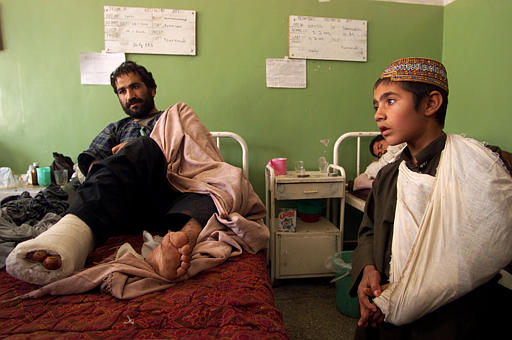 |
|

Devil's Garden
Afghanistan, laden with an estimated 10 million landmines, has been likened to one big minefield. Landmines and UXOs pose an ever-present risk to refugees, internally displaced persons, livestock, farmers, and children. They are planted indiscriminately over most of the country. Grazing areas, agricultural land, irrigation systems, residential areas, roads, and footpaths. The Soviets used mines in rural areas to depopulate the provinces in order to maintain better control over the population clustered in cities. After the Soviet the withdrawl, the civil war in Afghanistan brought heavy mining into the cities as factions fought for control over urban areas. (Monin, 2001, p. 162) Operation Enduring Freedom added American cluster bombs and bomblets to the mix.
For years landmines have been a major obstacle to repatriation, relief, rehabilitation, and development activites. Only 2 of Afghanistan's 29 provinces are believed to be free of landmines. Landmines and UXOs are believed to contaminate over 724 million square meters of land in Afghanistan, with mined areas still being discovered at a rate of 12 to 14 million square meters a year. The full extent of the problem has yet to be determined. (HRW, 2003) Landmines kill or maim more civilians in Afghanistan than in any other country. Each month an estimated 150 to 300 people are killed or injured by mines or UXOs. The actual number could be much higher, given the deaths and injuries that go unreported. An estimated 50% of mine victims die before reaching a medical faciltiy. This appallingly high number of civilian casualties will likely increase as refugees and the internally displaced move through familiar and unknown territory. (ICBL, 2003) Afghanistan joined the 1997 Mine Ban Treaty in September 2002. Use, production, stockpiling and trade of antipersonnel landmines is now prohibited. Mine action operations in the country have resumed with vigour and it is hoped that other activities to implement the convention will soon begin. Banning landmines is a significant step for a country almost synonymous with landmines.
It's been estimated that 4% of the Afghan population is disabled as a result of landmines and UXOs. For many, life with a disability means a virtual social death. For others, it means that a life already wrought with adversity is further compromised by the meager resources available for medical care, rehabilitation, and socio-economic reintegration. Afghanistan is the most heavily mined country in the world. Mine clearance is the leading job sector in Afghanistan today. (Shahryar, 2002) Without an aggressive clearance program, Afghanistan will never fully overcome the legacy of war which has tortured this fragmented society.
|
|---|


